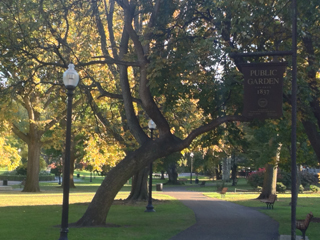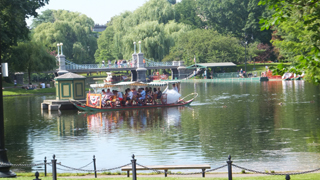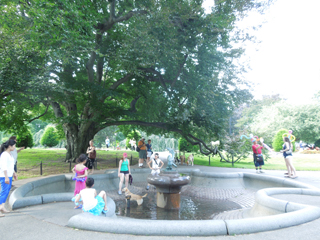PUBLIC GARDEN
Visited July 15th,2013
A Victorian style garden with imported exotic trees and a lagoon with mute swans and ducks, now occupies what had been salt marshes on the edge of the Boston Common during Colonial times. Cara and I had left the turf of the Boston Common and crossed Charles Street to a pleasure garden, open to the public for leisure and enjoyment. Simply named Public Garden, it recognizes the citizens of Boston’s fight to maintain an open space to be used as a garden for the public in a growing and overcrowded urban area.
During the early 19th century marshes were filled in as dry land, extending the city streets westward in downtown Boston. A public park of 24 acres was established in 1837 as a botanical garden near the center of the city. Currently the park is surrounded by heavy traffic with the sight of contemporary skyscrapers through the open spaces in the garden.
The park had gone thru numerous changes before buildings reached skyward and automobiles were the mode of transportation. In the early 1800’s as the filled land increased in value, there was a tug of war between the city for real estate development and the citizens for a botanical public garden on this site. With votes in 1824 the citizens of Boston who wanted open land for health and recreation, blocked the city council from selling the land for building purposes.
Thirteen years later a wealthy iron manufacturer and horticulturist, Horace Gray took the initiative to form an association with 17 other Boston horticulturist to establish the swampy land that lay below street level and was subject to tidal flooding, as a public botanical garden. Gray envisioned a European garden so hired an English landscape gardener, John Cadness to supervise an ornamental public garden. A boardwalk was built from west to east on the Gardens entrance on Beacon Street and lined with ornamental plants and trees.  Tulips bulbs were imported from England, a great expense at that time. A former circus building near the corner of Beacon and Charles Street was converted into a conservatory for exotic plants and birds.
Tulips bulbs were imported from England, a great expense at that time. A former circus building near the corner of Beacon and Charles Street was converted into a conservatory for exotic plants and birds.
The Public Garden became very popular with the citizens of Boston. Horace Gray’s generous funding over the next nine years was the primary source of financial support for the garden. The garden ended suddenly in 1848 with a major loss of his fortune due to faulty investments and a fire that destroyed his conservatory in the garden.
The garden was returned to the city and the land was considered again for residential real estate. The public once again protested being led by Reverend Charles Barnard who organized a public relation campaign. He successfully emphasized the health and recreational benefits of a garden for all citizens. The state legislature listened to the people of Boston and passed the Public Garden Act in 1856 that decreed the land forever would be for the public use.
Boston architect George Meacham was the winner of a public design competition in 1859 to landscape the 24 acres of ground as a garden. Horace Gray has received the title of “Father of the Public Garden” but no trace of his garden remains. It is George Meacham’s initial landscape design that we primarily see in the Public Garden today. His winning design included colorful geometrical displays of flowerbeds, an ornate bridge over a serpentine pond, and play activities for children, fountains and winding pedestrian paths. City engineer James Slade and city forester John Galvin, were instrumental in laying out the paths, flowers, trees and turf.
There were dissenting voices against the Victorian gardenesque style of landscaping that was favored in the mid to late 1800’s. Charles Sprague Sargent, director of the Arnold Arboretum, considered the bright ornamental plantings bedded out in masses, often with elaborate patterns, as “horticulturally inappropriate.” He favored a natural and simple form of garden display. His criticism was ignored.
Tropical bright colored cannas combined with multi colored red and yellow crotons that were planted in large beds with tropical palms were popular with the public. Greenhouses allowed tropical plants to be over wintered and provided the garden with the thousands of annuals needed to provide the colorful displays for a Victorian garden.
In May the tradition of tulips in the garden continues with 26,000 tulips blooms providing a popular photo opportunity. The summer and autumn annual displays along the main paths that replace the tulips are bright and bold, still planted in masses that were favored in Meacham’s award winning original design. Over the years fourteen city-operated greenhouses located at Franklin Park, have been growing from seed the annual plants for the Public Garden and numerous other locations around downtown Boston.
Perennial plantings in the park are flowering shrubs and roses. Topiary yews surround four rose beds. A volunteer group with the Friends of the Public Garden, named the Rose Brigade, maintains the rose beds throughout the year, meeting weekly during the growing season.
The roses are cut down in early December and mounded to protect their root crowns thru the severe Boston winter. Early April the roses are uncovered and by mid June there are a few thousand roses in bloom. The earliest roses in the garden were planted in 1980, a testament to the meticulous care provided by the Rose Brigade volunteers.
Over time an iron fence with gates was put in place and William Doogue introduced perimeter plantings that further defined the boundary of the park. Granite basins with fountains and statues were added to the landscape. A lantern created in 1587 from a palace in Japan, was given to Boston as a gift by a Japanese immigrate, Bunkio Matsuki. Matsuki specialized in and was a promoter of Japanese art, antiques and culture in Boston. The iron lantern was permanently put in place by the lagoon in 1915.
Marking the arrival of spring for Boston citizens are the popular swan boats on the man made lagoon in the Public Park, an annual April to Labor Day feature. In 1877 shipbuilder Robert Paget, an English immigrant, designed his boats to portray the illusion that a swan was drawing them. His inspiration for the boat was the opera Lohengrin, in which a knight crosses a river in a boat drawn by a swan.
Descendants of Robert Paget have continued the business of providing an idyllic cruise on the lagoon in boats using Robert Paget’s invention, a foot pedal propulsion system powered by a captain with the pedals hidden behind the swan forms. The current boats are replicas of the original, (with additional benches) providing passengers a panoramic view of the beauty of the park from the center of the lagoon.
For decades children have adored a mother duck and her eight ducklings that make the Public Park their permanent home. A Caldecott award winning picture book by Robert McCloskey, “Make Way for Ducklings,” tells the story of a pair of mallards that have adventure in downtown Boston and the Charles River, searching for a safe home for their ducklings. The family finally makes their residence on an island in the lagoon in the Public Garden where people on the Swan boats throw peanuts to them for breakfast. Nancy Schon, a Boston area artist, created the bronze sculpture of the duck family in 1987 to celebrate the 150th anniversary of the Public Garden. The Annual Duckling Day parade on Mother’s Day is a popular event in the park with children wearing duckling attire and retracing the mallard’s route in the garden.
There was an overall decline in the Public Garden in the 1950’s and 60’s, which affected the condition of trees, statues, fountains and fencing. It was the citizens of Boston who responded again by forming an organization in 1970 to protect and prevent any changes that would be detrimental to the parks. Named Friends of the Public Garden, they work with the Boston Parks Department to restore and protect Boston’s three historic downtown parks, the Boston Common, Public Garden and Commonwealth Avenue Mall.
Fountains and sculptures were restored, new benches and fencing were put in place and needed tree care funded. The parks were again returned to the public for a respite from the surrounding city. Owing to these efforts the Boston Public Garden has been placed on the National Register of Historic Places and is designated a Historic Landmark.
It is difficult for the city to adequately fund the expense of tree care, exacerbated by urban pollution, compaction and disease. The Friends of the Public Garden provide a considerable amount of capital through an endowment fund to provide professional planting, maintenance and disease treatment for over seventeen hundred trees in the three parks. Currently in the Public Park there are over 600 trees, native and imported with more then 100 varieties. As an education service The Friends of the Public Garden have added labels on many of the trees with the species common, Latin botanical and family name with place of origin.
The Dutch Elm disease has continued to take a toll on the character of the Public Garden as sixty years ago a third of the trees were American elms. The Ulmus americana is Massachusetts official State tree in honor of General George Washington, who took command of the Continental Army underneath an elm tree on the Cambridge Common in 1775. Only a few American elms remain in the garden today. The English Elms in the garden are also vulnerable to the disease. An expensive inoculation program is carried out yearly by the Friends of the Garden for all of the in the elms in Public Garden, the Common and Commonwealth Avenue Mall.
Numerous native and exotic trees from Europe, Japan and China are found in the Public Garden. Many of the names we are familiar with – varieties of beech, birch, European and American elms and a California Redwood that line the curved pathways or stand individually in the landscape. Ginkgoes, oaks, linden and maples contribute fall colors.
After the Boston winter the spring blooms of Magnolia, dogwoods, crab apples, cherries, redbuds, plum and Horse chestnut are welcomed by Bostonians. Weeping Willow trees are numerous around the perimeter of the lagoon with their boughs dipping their branches into the lagoon. Benches are placed in the park where mature trees provide shade.
One tree of the garden carries in its numerous feathery, soft green needles the tale of dinosaurs, extinction, and celebratory discovery. It is the story of a 20th century young Chinese botanist who made a lone, perilous journey to collect the cone seeds that eventually made their way from a remote mountainous area of south-east China to Boston at the Arnold Arboretum of Harvard University. A deciduous conifer with mature height over one hundred feet and a girth of seven feet or more, the ancient Metasequoia Glyptostroboides, or commonly named Dawn Redwood, is a recent discovery less then 70 years ago.
The Dawn Redwood was presumed to be extinct, the sole species of Metasequois S Miki, a genus described from fossil material found in the clay beds of Central Honshu dating back to the Mesozoic or dinosaur era. It was described in writings in1941 by the Japanese palaeobotanist, S. Miki. That same year a peculiar deciduous tree was found in Sichuan, China. The natives revered the tree naming it shui-shan or water fir as the tree had the ability to thrive in standing water or along small streams and near rice paddies.
It was not until 1944 that specimens of the tree could be collected. It was then determined the specimens belonged to a conifer genus previously unknown in the living flora of China. In 1946 botanist Chi-ju Hsueh was sent by Professor Wan-Chun Cheng to search for the trees and collect more material. Additional herbarium specimens were collected and Professor H. H. Hu, in Beijing, then wrote a paper announcing the discovery of what was called “the fossil-tree.”
Professor Hu had been the first Chinese botanist to receive a doctorate from Harvard University so he contacted Dr. E.D. Merrill, director of the Arnold Arboretum, telling him of the discovery of the tree of the fossil genus. He requested and was given a donation from the arboretum of $250.00 to finance Hsueh to return to Sichuan to collect seeds.
Hsueh recalled in a short memoir he wrote in later years of his first trip to the mountainous village Modaoqi, to collect specimens in February of 1946. He traveled alone in the cold through the mountain passes between the border between Sichuan and Hubei provinces, which was a dangerous area due to frequent robbery and murder of travelers. He walked seventy-two miles over 3 cold days until he found the Dawn Redwood tree located at the end of a small street in the village. It was twilight. He could see that he could not climb the gigantic tree, (122 feet in height and 23 feet in girth) whose branches were now leafless. He said that his excitement cooled. It was his thought that he would only be able to bring back dried branches. With no tools he threw stones at the tree. With good fortune leafless branches fell with many male yellow cones and some female cones. He wrote that he “jumped with joy and excitement!” A return trip was made in May of that year for additional studies and collection. It was in late fall of 1947 that an ample supply of seeds were collected and forwarded to Boston. Hsueh’s adventure is a story of the passion of a 20th century plant explorer.
The seeds collected were planted in the Arnold Arboretum’s greenhouses in January 1948, and germinated quickly. The arboretum was then able to share seeds with other institutions in Great Britain, Europe, Eastern Asia and America. As a smaller cousin of the sequoia and a fast grower, the Dawn Redwood has become a popular landscape tree in numerous countries where there is a wet, temperate climate. This mature Dawn Redwood at the Public Garden is from the original seeds collected. The tree was given to the Public Garden in 1963.
Spanning the narrowest part of the lagoon is a gray stone and iron suspension bridge designed in 1867, and later converted to a girder bridge. Walking across this bridge westward connects to the main footpath to Arlington Street on the opposite side, a connection to the green center of Commonwealth Avenue. Nine blocks of a formal planting of trees, originally designed in a French boulevard style, unites the Back Bay with the downtown area, part of Frederick Law Olmsted’s design of the Emerald Necklace.
Before leaving the Public Garden for a walk to the Back Bay Fens, an imposing bronze equestrian statue, by Charleston native Thomas Ball, faces Commonwealth Avenue standing an imposing 22 feet high on a 16- foot pedestal. Our Founding Father, George Washington, visited Boston in 1789, dressed in his Continental uniform and riding a handsome white horse. He was greeted near the Boston Common with fanfare and excitement by Bostonians of all ages. Now George Washington is immortalized on his rearing mount as Commander in Chief of the army, an historical reminder of Boston’s link to the founding our country.
Photos: by Deborah McMillin and Cara McMillin
Fall photos by Cara McMillin
References:
Boston Art Commission
Friends of the Public Garden
Harvard University. Arnoldia Volume/Number 58/4 59/1 1998-1999
Morgenroth, Lynda. Boston Firsts. Boston: Beacon Press 2006





















